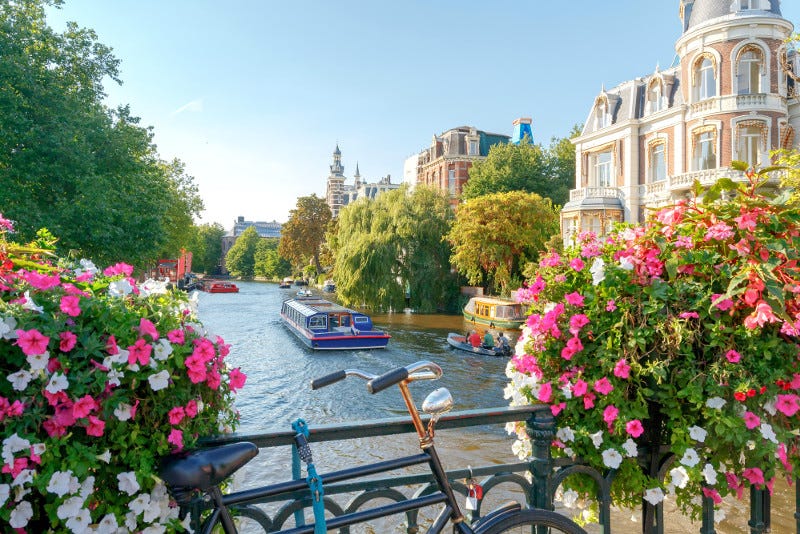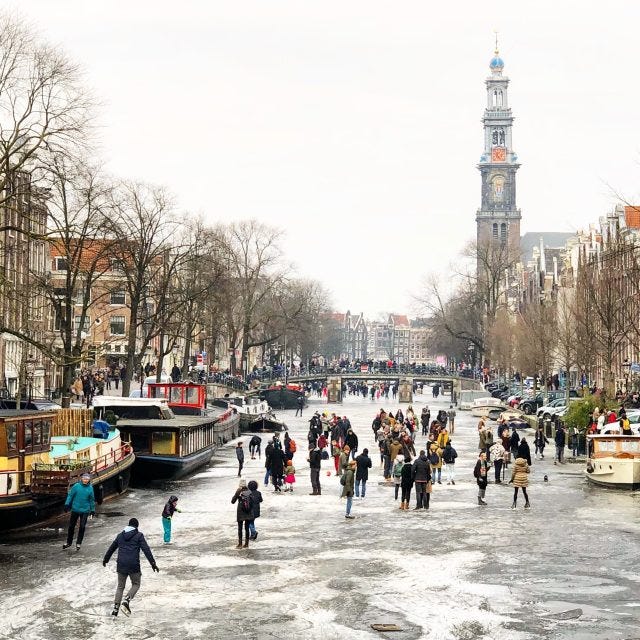It seems everybody around me is getting obsessed with cities and urbanism. And rightly so. Our cities define who we are, what we do, and how we live. Like for partners, I urge everyone to try different cities before settling on the one to spend many years of your life with. I’m lucky to report I have found mine: Amsterdam.


This essay is inspired by David Perell’s What’s Up With Austin? which does an excellent job painting the picture of Austin from a resident perspective. I’ll try to do the same for the Venice of the North, even though I think my writing can’t quite compare.
The most beautiful city on Earth?
The first thing that strikes you when you get to Amsterdam is how beautiful it is (especially if you’re used to American cities like Austin…)
Whether you’re coming by plane, boat, or train, it is likely the first view you’ll have is from Centraal Station, which is geographically the center of the city. It would look like this:
Walk to the other station, and this is what you get:
Gorgeous, isn’t it?
If I ask you to think of Amsterdam, what is the first word that comes to mind? “Canals” is likely to be in there. “Bikes” and “weed” are also good contenders, but we’ll get to those two.
Canals. Yes, they’re worth the hype. Combined with the picturesque and traditional Dutch architecture, they can make you want to spend hours on a stupid bridge.
So how come Amsterdam is so pretty? It all goes back to the 17th century, the Dutch golden age. This was a very prosperous time for the Netherlands, which historians explain by four factors:
A culture of tolerance. Inspired by humanism, the Netherlands was welcoming to plenty of cultures, ideas, and religions, which stimulated the immigration of persecuted people and liberal minds.
The protestant work ethic. Protestants love discipline, frugality, and achievement. These are always a good recipe for economic success.
Good geography. Ideally located between European powerhouses, with immediate access to the sea and the Rhine and plenty of wind to power the mills, the Netherlands won the geographic lottery.
A tendency for international trade. The maritime predispositions of the Dutch made them excellent traders, resulting in two major companies: the Dutch East India Company and the Dutch West India Company, which controlled the world’s seas and obtained many monopolies.
During this century, the Dutch became really rich, and their cities expanded quickly. Merchants started building impressive houses to show their status. And these houses still stand today, even if a little crooked.
Interestingly, the Dutch Golden Age doesn’t refer only to trade but also to their advances in science and art. As if economic prosperity had positive second-order effects…
Urbanism, architecture, and canals: Amsterdam owes a lot to the 17th century. When I moved there three years ago, I had never set foot in the Netherlands. I had no idea what Amsterdam even looked like. And its beauty took me by surprise. I don’t know if you can have a crush on a city, but I definitely did.
A city of wealth
Another thing that keeps surprising me here is: where are all the homeless people? Every Western city is supposed to have some, but they’re very hard to find in Amsterdam.
Numbers first: thanks to its glorious history, relatively unaffected by changes or disasters, the Netherlands has a very high GDP per capita and one of the lowest income inequality rates on Earth (measured by the Gini Index).
In his book review of San Fransicko, Scott Alexander reviews Amsterdam’s policies regarding drug users and homeless people. It’s a bit confusing, and it seems there are actually quite a lot of them. Still, the city has apparently done an excellent job of housing them and ensuring they are offered treatment and support.
Amsterdam is also a very safe city. It is ranked the sixth safest city worldwide by The Economist. I don’t know if it’s a factor many people consider when choosing where to live, but there’s something incredibly liberating in not worrying about where to walk or whether you can check your phone in public.
There used to be way more crime in Amsterdam, especially in districts like Bijlmer, but clever urban renewal policies made it drop significantly in the last two decades. An example is the use of “single plane” streets. They are roads shared by cars, bikes, and pedestrians, which create direct sightlines: everyone on the street and in the buildings can see what’s happening.
Obviously, it is great to live in a wealthy and safe city. But there is a counterpoint: everything is so damn expensive. Finding a home is a chore, and I know very few people who live alone. Tradeoffs, I guess.
Think free
Due to its tradition of liberalism and “intellectual tolerance,” Amsterdam is also famous for its many legal activities.
The city is home to over 160 coffee shops, which often don’t even sell coffee. You can also buy magic truffles and nootropics in smart shops. And even though it’s technically illegal, the Netherlands probably has the best MDMA on the planet.
One interesting thing to note is that, while it’s legal to sell cannabis, its production is punished. Consequently, there is very low transparency regarding the product's origin and quality. I have found California to be a way better place to buy weed than the Netherlands.
There is then, of course, the Red Lights District and its famous display cases. While it makes for interesting tourist entertainment, it is sinister, and I don’t recommend it.
Again on the “liberal” mindset, Dutch culture favors entrepreneurship and business. You can see that in its fiscal policy: the Netherlands is sometimes considered a tax haven. The rest of Europe doesn’t like it, but it’s working well: many international corporations have their European headquarters in Amsterdam or its surroundings. Nike, Cisco, Adidas, Booking.com, Tesla, Panasonic, and Netflix are just a few examples.
Another interesting fact about the Netherlands is that it is one of the most irreligious countries in the world. More than half of the population has no religious affiliation (compared to around 23% in the USA).
From this follows a quite materialistic and realistic culture, where individual liberty is one of the most important values.
Thus, up there with San Fransisco and Berlin, Amsterdam is one of the most LGBT-friendly cities, and Pride is celebrated very cheerfully every year.
A great place to work
Still on the liberalism thing: if you’re somewhat educated, Amsterdam is a land of opportunities. The city has made a point of attracting foreigners. There are between 80,000 and 110,000 expats in Amsterdam, for a total population of ~900,000.
I am one of them, and I love it. The tech scene is interesting, the infrastructures are excellent, and everyone speaks perfect English.
But what surprised me the most was a very healthy work-life balance. The lights are out by 5 PM in most places, and you basically get kicked out if you’re staying any longer than that.
Living on two wheels
Now about the bikes. Yes, the hype is real: with mostly flat terrain, very few cars in the inner city, and more than 400km of bike paths, it is great to cycle in Amsterdam. And the numbers show it: there is roughly one bike per person here.
It’s interesting to note that cycling really is the most convenient way to travel. The roads are very narrow — most are one-way only, and parking fees are exorbitant, so cars are a no-go. Walking is fine, except the sidewalks are also narrow, and you’re always at risk of getting hit by a bike.

Public transports (trams and metros especially) are very good and clean, but they tend to be on the expensive side and are most convenient to travel outside the center.
Cultural (in)significance?
Amsterdam’s cultural scene is okay. There’s plenty to do, but Paris, Berlin, and London all seem way more influential and exciting. My theory is that Amsterdam is too nice; it doesn’t have the edge or the pretentiousness of other nearby capitals.
Still, Museumplein (Museum square) hosts many world-class museums like the Rijksmuseum (classical art), the Stedelijk (modern art), the Moco (contemporary art), the Van Gogh Museum, and the Diamond Museum.
The music and nightlife scenes are where Amsterdam shines, with two legendary venues (Paradiso and Melkweg) and some of the best electronic music festivals in the world, like the Amsterdam Dance Event (350,000 participants every year!) or Dekmantel, where all my favorite DJs are playing but I’m too poor to afford a ticket.
What else? Well, there are many great things to do in Amsterdam (bars, comedy, galleries, festivals), but none of them are worthy of a specific mention here. Amsterdam is a city where people love to chill more than do things. For example, it is very common for residents to sit on a bench or on a table in front of their house (yes, on the street) and enjoy a couple of biertjes.
The not-so-great things
It is wet and cold
The weather is mostly terrible, and it is the number one reason why people I know move out of the Netherlands. Not only does it always rain, but the weather is simply unpredictable. The seasons never look the same year over year; you can have an unbearably hot summer or no summer at all, snowfalls in April… You often go through every season in a single day.
The only thing Amsterdammers can rely on is Buienradar, a must-have app that tells whether rain is expected in the next hour.
Don’t talk to me about the food
There’s this recurring joke about the Netherlands’ historical spice trade and their absolute refusal to season any food. Don’t get high on your own supply. Even Wikipedia throws shade:
Dutch cuisine is characterized by its somewhat limited diversity.
The cuisine here is bland and gross. I sometimes wonder how the Dutch are the tallest and among the healthiest in the world with so little variety and so many saturated fats in their diet.
A wonderful Instagram account, Daily Dutch Lunch, highlights the typical tastes of the people here through pictures of their lunch. You might think they only feature the worst of the worst, but I see similar horrors daily at my office.
Fortunately, the culinary experience is salvaged by Amsterdam’s cultural melting pot. All the expats and immigrants have brought their good food along with them, and there are many excellent international restaurants. Phew!
What is the future of Amsterdam?
If Europe doesn’t collapse anytime soon, I believe Amsterdam will be a city of the future. It has very solid foundations but also a clear longer-term vision. The municipality’s website contains a lot of information regarding its policies. I think it’s great to have this stuff public and easily accessible (and in English)!
The tagline for the 2050 vision is “A humane metropolis.” Let’s dive into the five “strategic choices” that will take the city there.
Polycentric development: move away from “one center,” better distribution of services and job opportunities, development of some neighborhoods, expansion of public transport.
Growth within limits: the city expects “250,000 new residents in 2050,” and it set itself up for an interesting challenge: host these people without expanding the city! That means increasing the density and improving the usage of certain areas. The how is a bit unclear, but I think many YIMBYs would love the idea.
Sustainable and healthy mobility: have “the whole of Amsterdam as a walking and cycling city.” So, even fewer cars! Very excited about this one.
Rigorous greening: more parks and green public space, investment in landscape (whatever that means.)
Making the city together: more local governance and more equal access to city planning.
I think these goals are pretty sane and concrete, and I’m very much looking forward to seeing these things happen.
Move to Amsterdam
If the parts about the food and weather didn’t completely turn you off, I hope to have made a compelling case of why Amsterdam is a great city and why it has the potential to be even greater.
My goal with this post was to write a public love letter about why I love this quirky, beautiful place. There were also more selfish reasons: to convince you, dear reader, that you should consider moving here, or at the very least visit it for a couple of days. You’d make a great addition to the city, and I’d have even more local friends!
See you soon?















Thank you for this great article as always ! I love the way you presented the city. Makes me want to come back soon ! I am personnally too attached to food and sunny weather to live there full time (and Austin is typically more a candidate to being my dream city) but I am glad you found 𝑦𝑜𝑢𝑟𝑠.